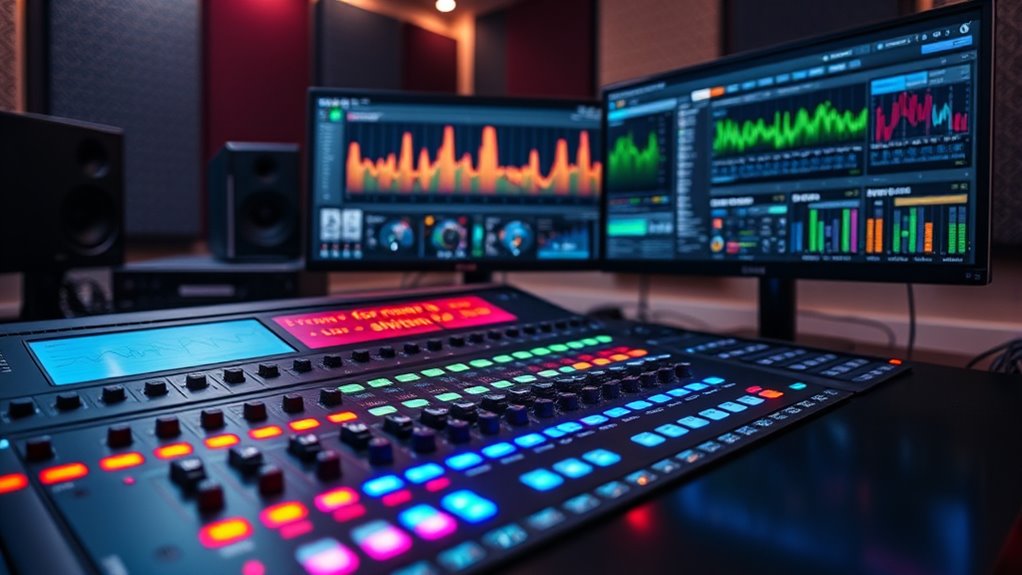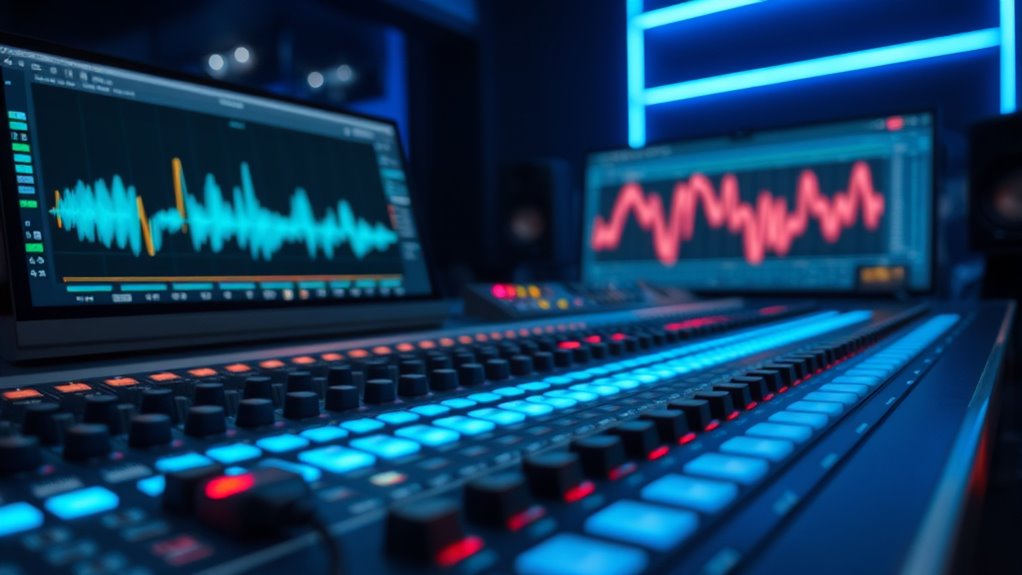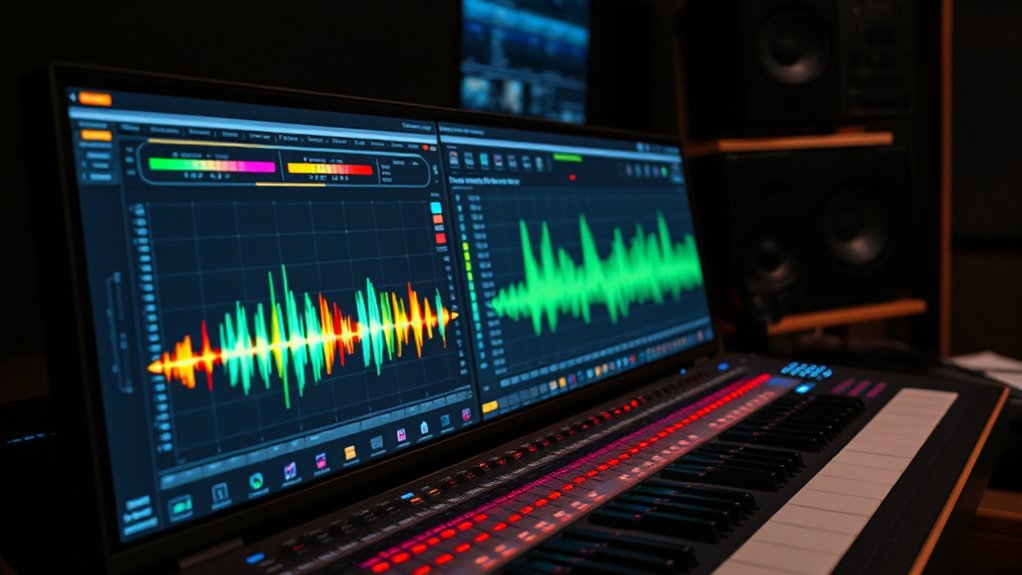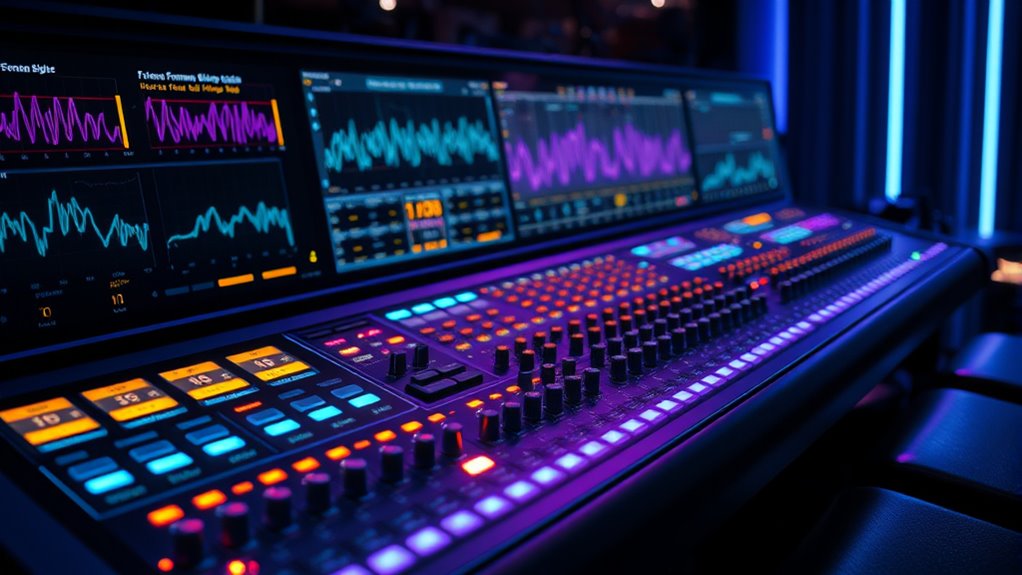To shift formants for alien vocals without losing intelligibility, use high-quality, formant-preserving plugins designed for natural sound. Make subtle adjustments, listening carefully to avoid distorting speech clarity or creating unnatural tones. Focus on matching formant shifts to the emotion or character you want, and blend spectral adjustments smoothly. Monitoring throughout the process helps maintain intelligibility while transforming your voice effectively—keep exploring to learn more tricks for perfect alien sounds.
Key Takeaways
- Conduct thorough formant analysis and apply subtle, gradual shifts to prevent unnatural or distorted sounds.
- Use formant-preserving algorithms or spectral shaping tools to maintain vocal intelligibility during pitch or tone adjustments.
- Regularly listen critically to balance alien characteristics with clarity, adjusting shifts to avoid muddiness or artifacts.
- Match formant shifts to vocal emotional context—light shifts for cheerful tones, careful handling for somber or intense voices.
- Enhance resonance and spectral blending post-shift to deepen alien qualities while preserving the natural clarity of the vocals.
Understanding the Basics of Formants and Their Role in Speech

Formants are the natural resonant frequencies of your vocal tract that shape the sound of your voice. They play a vital role in vowel perception, allowing listeners to distinguish different vowels based on their unique formant patterns. When you produce speech, your vocal tract acts like a filter, amplifying certain frequencies to create speech resonance. These resonances give your voice its distinct qualities, making speech intelligible. Understanding how formants influence speech helps you recognize how vowel sounds are formed and how altering formants can change perceptions of pitch or tone. By controlling speech resonance, you can modify your voice—whether for creative effects like alien vocals or clearer communication—without losing clarity or intelligibility. Knowing this foundation is essential for effective formant shifting. Additionally, adjusting formant frequencies can help maintain natural-sounding speech even when altering pitch or tone.
Choosing the Right Tools and Plugins for Formant Shifting

When selecting tools for formant shifting, make certain they’re compatible with your digital audio workstation to avoid technical issues. Listen closely to their sound quality to guarantee your alien vocals stay clear and natural-sounding. Comparing different plugins can help you find the best balance between ease of use and audio fidelity. Additionally, considering the bedroom environment in which you’ll be working can influence your choice of equipment and settings for optimal results.
Plugin Compatibility Tips
Choosing the right tools and plugins is essential for effective formant shifting, as not all audio processing software offers the same capabilities or compatibility. To guarantee smooth workflow, consider plugin compatibility with your DAW and hardware integration. This helps prevent glitches and latency issues. When selecting plugins, keep these tips in mind:
- Check if the plugin seamlessly integrates with your existing setup.
- Opt for plugins known for stable performance across multiple platforms.
- Prioritize those that support hardware controllers for real-time adjustments.
- Be aware of the hardware requirements to ensure optimal performance and avoid resource conflicts.
These considerations help avoid technical roadblocks and ensure your formant-shifting process remains fluid. Ensuring compatibility reduces troubleshooting time and guarantees your tools work harmoniously. Ultimately, choosing the right plugins enhances your ability to craft alien vocals without sacrificing sound quality or intelligibility.
Evaluating Sound Quality
Evaluating sound quality is crucial when selecting tools and plugins for formant shifting, as the right options can greatly impact the clarity and realism of your alien vocals. Focus on audio fidelity to confirm the processed vocals remain natural and detailed, avoiding artifacts that can distort the sound. High-quality plugins preserve subtle nuances, making the vocals more convincing and engaging for listeners. Test different tools with your specific audio material to compare how well they maintain clarity during significant formant shifts. Consider user reviews and professional benchmarks to gauge their performance. Ultimately, choosing plugins that prioritize sound quality helps you craft alien vocals that are both believable and captivating, enhancing listener engagement while retaining intelligibility. Additionally, understanding the importance of sound quality in audio processing can guide you in making better plugin choices for your projects.
Preparing Your Vocal Recordings for Effective Formant Manipulation

To achieve effective formant shifting, establishing a clean, well-recorded vocal track is vital. Start by optimizing your room acoustics to minimize unwanted reverb and echoes, guaranteeing clarity. Use vocal compression to control dynamics and maintain consistent volume, which makes formant adjustments more predictable. Additionally, focus on these key points:
- Record in a treated space to reduce room reflections
- Apply gentle vocal compression to smooth out inconsistencies
- Use a high-quality microphone for capturing detailed frequencies
- Understanding signal clarity helps in preserving intelligibility during processing
These steps help create a solid foundation, preventing artifacts during formant manipulation. Proper room acoustics and compression guarantee your vocals are clean and balanced, making the shifting process smoother and more natural. This preparation is indispensable for preserving intelligibility and achieving realistic alien vocal effects.
Techniques for Shifting Formants While Preserving Speech Clarity

When shifting formants, maintaining speech clarity requires careful technique to avoid distortion or loss of intelligibility. Start with accurate formant analysis to identify how vocal characteristics change with pitch adjustments. Use spectral shaping tools or formant-preserving algorithms to modify formants without affecting the vocal fundamental frequency. Vocal harmonization techniques can help mask slight distortions and reinforce intelligibility, especially when creating alien sounds. Focus on subtle shifts; large adjustments often cause muddiness or unnaturalness. Regularly listen critically to ensure the speech remains clear. Combining precise formant analysis with gentle shifts preserves vocal intelligibility while transforming the voice. Employing proper microphone placement and room acoustics can further enhance the clarity of recordings, making your alien vocals more intelligible. This approach helps you achieve otherworldly effects without sacrificing the clarity essential for understanding speech.
Tips for Achieving Otherworldly yet Intelligible Alien Voices

Achieving an otherworldly yet intelligible alien voice hinges on balancing creative sound design with clarity. Use vocal modulation and pitch shifting carefully to create unique tones without sacrificing intelligibility. Focus on these tips:
- Experiment with subtle formant shifts combined with dramatic pitch shifting to maintain speech comprehension.
- Use vocal modulation to add character without obscuring key consonants and vowels.
- Adjust pitch shifting gradually, avoiding extreme changes that distort speech clarity.
- Incorporate dog names that evoke a sense of personality and distinctiveness to inspire your vocal character design.
Common Mistakes to Avoid When Modifying Formants

Be careful not to over-process your formants, as excessive adjustments can make your vocals sound unnatural or confusing. Also, ignore the vocal context—what works for one sound may not suit another, so always consider the overall tone. Staying mindful of these mistakes helps you create more believable and effective alien voices. Incorporating proper comfort solutions can also enhance your workflow and output quality.
Over-Processing Formants
Over-processing formants can easily lead to unnatural or harsh vocal sounds, so it’s important to prevent excessive adjustments. Over processing formants often results in formant distortion, making the voice sound artificial or difficult to understand. To prevent this, keep these tips in mind:
- Make subtle, gradual changes rather than drastic shifts
- Listen frequently to ensure the vocal remains intelligible
- Use modulation sparingly to avoid unnatural tonal jumps
- Be mindful of sound perception to maintain natural vocal qualities.
Ignoring Vocal Context
When modifying formants, it’s crucial to take into account the vocal context to maintain naturalness and clarity. Ignoring vocal tone and emotional expression can lead to unnatural or unconvincing results. Adjusting formants without considering the original vocal characteristics risks distorting the voice, making it sound robotic or disconnected. For example, a cheerful tone might need subtle shifts, while a somber tone requires more careful handling. Use the table below to guide your adjustments:
| Vocal Tone | Formant Adjustment Tips |
|---|---|
| Happy | Slightly raise formants for brightness |
| Sad | Lower formants for warmth and depth |
| Angry | Sharpen formant shifts for intensity |
| Calm | Gentle shifts, preserving naturalness |
| Emotional Expression | Match shifts to the mood for authenticity |
Always tailor your modifications to the vocal context for authentic results. Being aware of tent camping locations and their characteristics can help you better understand different natural environments, which in turn informs how you might approach vocal modifications in various emotional states.
Finalizing and Refining Alien Vocal Effects for Maximum Impact

To achieve maximum impact, you need to carefully fine-tune your alien vocal effects by listening critically and making targeted adjustments. Focus on enhancing vocal resonance to deepen the alien quality without sacrificing clarity. Spectral blending is key—smoothly merge your effects to create a cohesive, otherworldly sound.
Fine-tune your alien vocals by enhancing resonance and spectral blending for a clear, otherworldly sound.
Consider these steps:
- Adjust formant shifts to emphasize unique vocal resonance traits.
- Use EQ and filters to refine spectral blending, avoiding harshness.
- Fine-tune modulation and dynamics for natural-sounding alien textures.
Frequently Asked Questions
Can Formant Shifting Be Applied to Non-Vocal Sounds?
Yes, you can apply formant shifting to non-vocal sounds, including instrumental synthesis, to alter sound texture creatively. By adjusting formants, you reshape the tonal qualities of any audio, making it sound more alien or unique. This technique helps you experiment with sound design and achieve desired effects without losing clarity. So, feel free to explore formant shifting on various sounds to enhance your musical and sound design projects.
How Does Pitch Shifting Interact With Formant Adjustments?
Perfect pitch preservation pairs perfectly with formant correction, preventing your voice from sounding distorted when you shift pitch. When you modify pitch, it’s vital to understand how it interacts with formant adjustments—changing pitch alone can cause alien-like artifacts. By carefully combining pitch shifting with formant correction, you keep your vocals intelligible, authentic, and appealing. This technique guarantees your sounds stay smooth, stable, and sonically satisfying, even after substantial pitch alterations.
Are There Specific Genres That Benefit Most From Alien Vocal Effects?
You’ll find that experimental genres and futuristic soundscapes benefit most from alien vocal effects. These styles thrive on unique, otherworldly sounds that push creative boundaries. Using alien vocals adds a surreal quality, making your music stand out. Whether in ambient, glitch, or electronic tracks, these effects enhance the atmosphere and evoke a sense of the unknown. Embrace these genres to experiment freely and craft innovative, mesmerizing sonic experiences.
What Hardware Options Exist for Real-Time Formant Manipulation?
Imagine you’re performing live and want instant voice transformation. Hardware options for real-time processing include the Roland VP-03 Vocoder or the Eventide H3000, both offering immediate formant manipulation. These devices enable seamless control, ensuring your alien vocals stay clear and intelligible. You can tweak parameters on the fly, making them ideal for live performances or studio sessions where quick, reliable results matter most.
How Do Cultural Perceptions Influence Alien Voice Design Choices?
You should consider how cultural perceptions influence alien voice design choices, as cultural stereotypes and perception biases shape what audiences find believable or intriguing. When designing alien voices, you might emphasize certain traits to match or challenge these biases, making your creation more compelling. By understanding diverse cultural perspectives, you can craft sounds that resonate globally, avoiding stereotypes while creating a unique, engaging alien vocal identity that appeals across cultures.
Conclusion
Mastering formant shifting lets you craft alien voices that captivate without losing clarity. By understanding the nuances of formants and applying precise techniques, you can transform your vocals into otherworldly sounds that still communicate. Remember, the magic lies in balance—like a tightrope walker—where creativity meets clarity. With patience and practice, you’ll create extraterrestrial voices that enchant and intrigue, proving that even the most bizarre sounds can speak clearly through the art of formant manipulation.










